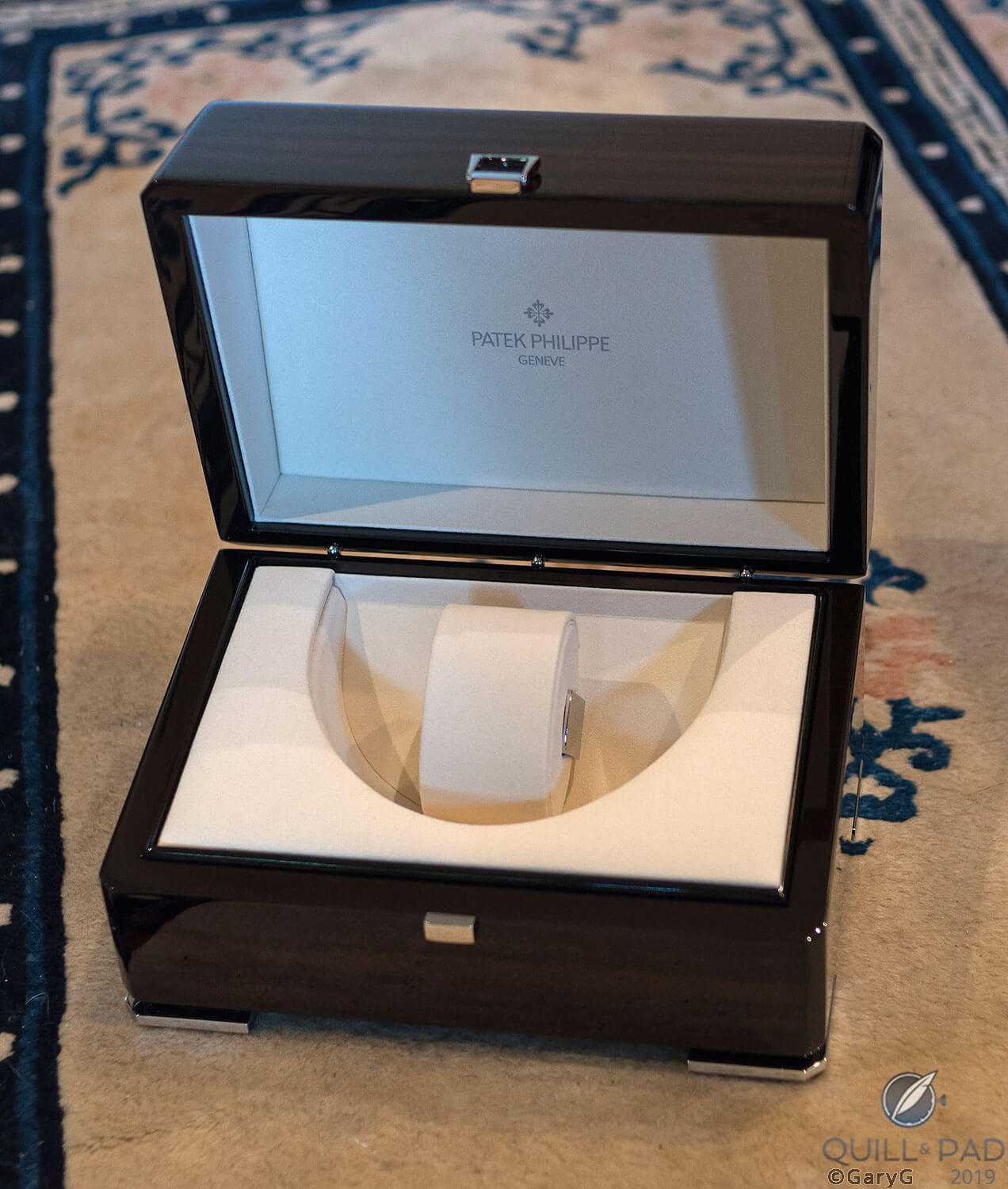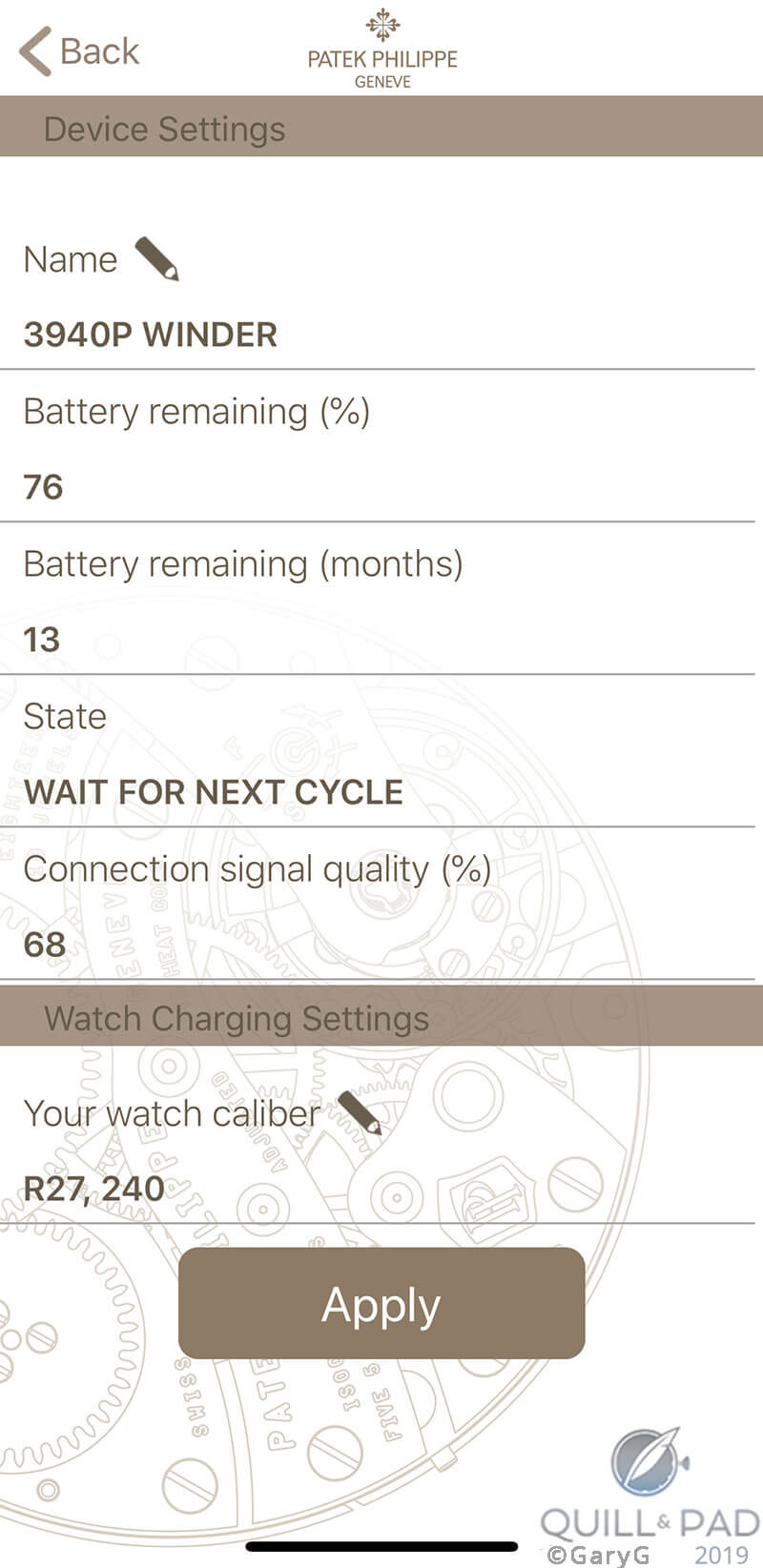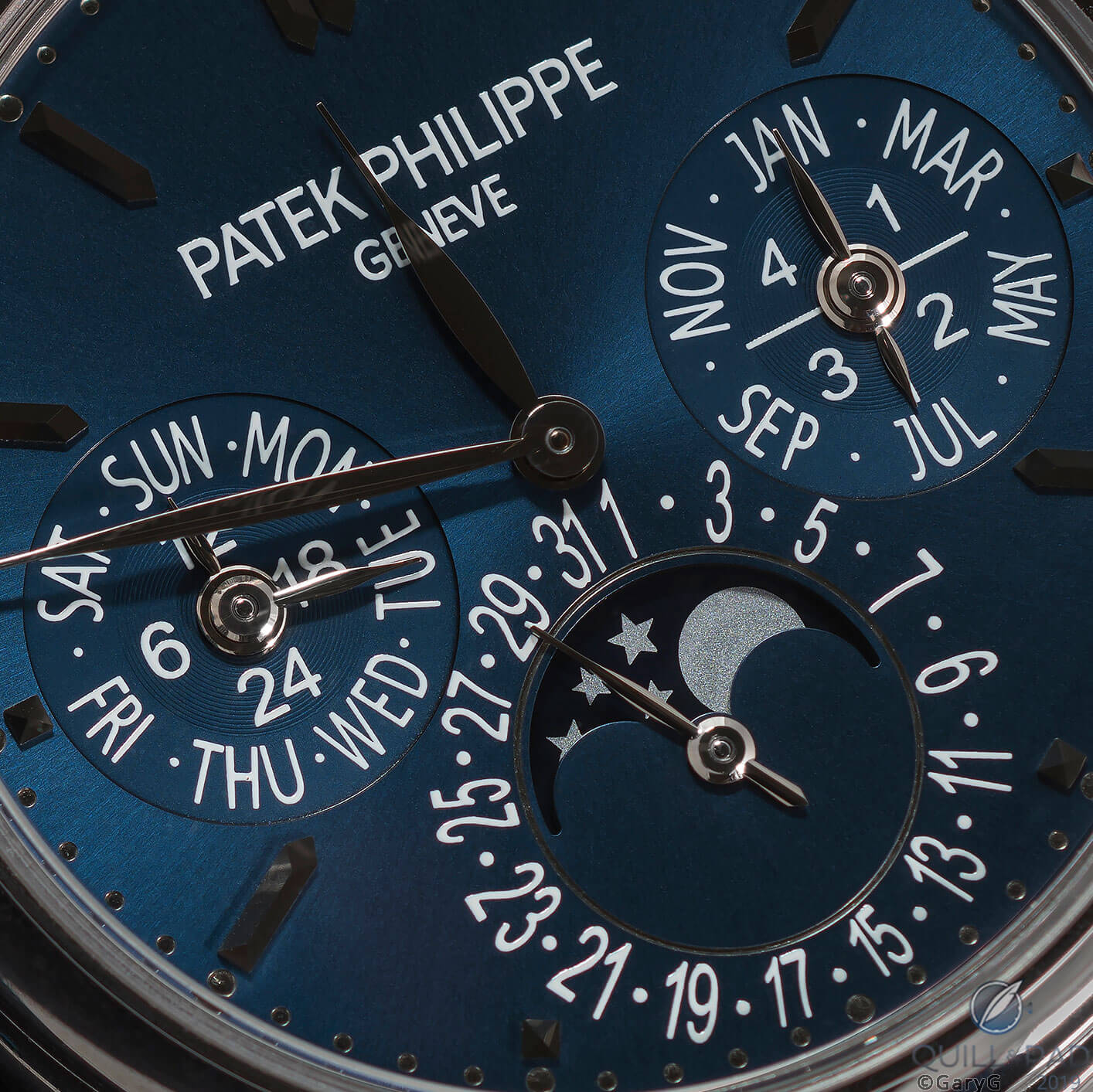Why I Bought It: Patek Philippe Reference 3940P-027 Vintage Collection
by GaryG
While my watch enthusiast friends don’t talk much about it, I’ve concluded that “access” is one of the most sought-after benefits associated with becoming an established member of our little community.
Access takes many forms including the opportunity to meet well-known collectors, invitations to brand events, introductions to touring independents, and inclusion in industry gatherings such as SIHH (now Watches & Wonders) and Baselworld (now defunct).
And, of course, somewhere near the top of the pile is access to watches, whether it’s the ability to drool over a new friend’s minute repeater, enjoying a private showing of a brand’s new products at a show, being shown the watches that a dealer keeps in the safe for “special” customers, or at the extreme being able to buy watches that aren’t offered publicly.

Limited access: Patek Philippe Reference 3940P with blue dial
Thanks largely to the kindness of friends, over the past ten years I’ve been fortunate to gain access to many people, places, and things that I thought would always be off limits to me. And November of 2018 marked a personal high point as I both served on the jury of the Grand Prix d’Horlogerie de Genève and took delivery of an “unobtainable” watch, the Patek Philippe Reference 3940P-027 pictured in the photo above.
————————————————————————————————————–
—————————————————————————————————–
Why I bought the Patek Philippe Reference 3940P-027 and how it fits
For context, perhaps it’s best to start with a few words about what this watch is: as a member of Patek Philippe’s Vintage Collection, it is a strictly limited “new old stock” re-issue of a long-discontinued Patek Philippe classic reference with some unique twists.
During the long lifetime (1985 to 2007) of Reference 3940, there was never a platinum variant with blue dial. And this new-production piece based on the period-correct (or, less generously, leftover) case and movement also differs from those in the original production run by merit of its Reference 5140-style dial fonts.

Rebirth of a classic: Patek Philippe Reference 3940P-027
In my pal Terry’s watch portfolio taxonomy, this piece falls directly into the foundational category: a watch that can be a bedrock piece within a collection and that should stand the test of time regarding importance, appeal, and value stability.
While it would be a bit boring if one’s collection consisted entirely of foundational watches, they complement the “fun” and “patronage” parts of a collection and allow a bit of adventure in the rest of one’s assortment.
The “why I bought it” part may seem obvious: after all, it’s not every day that you are presented with an opportunity to buy this sort of Patek Philippe rarity. But for me, it was much more than that: my pal and I were granted a peek at several Vintage Collection watches, including some considerably more complicated ones, this was the one that, even through the thick plastic, captured my heart.

Geneva sealed: Patek Philippe Reference 3940P in its thick plastic bag
That was in November of 2017. And after asking for, and receiving, the blessing of Patek Philippe management to buy the watch I went through a “selling-to-buy” cycle to raise the needed funds before traveling to the Patek Philippe Geneva Salon in November of 2018 for delivery day.
—————————————————————————————————–
—————————————————————————————————–
Why I love the Patek Philippe Reference 3940P-027
Let’s start with the delivery process: there’s just something about picking up a new watch in the presence of one or more buddies and doing it at the spiritual home of Patek Philippe at 41 Rue du Rhône that is as delicious as icing on the cake.

Big smiles and American champagne: pickup day at Patek Philippe’s Geneva Salon (photo courtesy TahoeBlue)
The labeling on the cardboard inventory box brought a smile as well! Sadly for me, Patek Philippe policy prohibits giving these original boxes to the customer, so a photo will have to suffice.

The name’s G, GaryG . . .
While it had been a bit of an act of faith to buy the watch without having seen it outside of its plastic cocoon, as soon as the watch had been liberated, I was dazzled by the striking blue dial. And when daylight returned the following morning, a view on the wrist in natural light further confirmed my initial assessment.
While this dial does not have the degradé transition from blue center to black edges that is present on my Reference 5170P, the starburst brushing radiating from the center of the 3940’s dial does a great job of creating a dancing play of light, while the specific hue of blue used is simultaneously vivid and deep.

Outdoors, on the wrist: Patek Philippe Reference 3940P-027
It’s about at this point in the article that you are probably expecting me to turn my attention to the watch’s movement. While I’m certainly a fan of Caliber 240 Q, which powers the Reference 3940, I won’t be regaling you with descriptions or even photos of it as it is concealed behind the solid platinum case back that is the standard fitment for the 3940P.

Move along, nothing to see here: solid case back, Patek Philippe Reference 3940P
I haven’t had the temerity to pop off the case back and check out the movement, so among other things I can’t confirm first hand that this watch has a Geneva Seal (rather than the Patek Seal) movement as fitted to the white gold/salmon dial Vintage Collection 3940s made at the time of Patek Philippe’s London Grand Exhibition.
There is something pleasantly old school about the solid case back, though it’s consistent with other features of this watch, including its classic 36 x 9 mm dimensions; relatively small, flat crown; and the omission of the small diamond between the lower lugs included on Patek Philippe’s more recent platinum cases.
—————————————————————————————————–
—————————————————————————————————–

Classic profile: case and crown of Patek Philippe’s Reference 3940P
As for the dial side, I’m a fan of the 5140-style dial look adapted to the smaller Reference 3940 case. Nothing drives me battier than subdials that are too close to the center of the main dial, and the smaller width of the 3940 dial vs. the 5140’s results in a more complete and harmonious look in my opinion.
While I understand that the variable sizing of the date numerals and larger fonts for the days and months are not to everyone’s taste, I prefer the legibility they provide.
I also very much like Patek Philippe’s choice of leaf hands for this sub-reference over the dauphine hands used on the original Reference 3940 variants, while the small pyramid-shaped appliqués at 3, 5, 7, and 9 o’clock help balance the dial and provide a bit of visual flash as well.

Hybrid dial and leaf hands, Patek Philippe Reference 3940P-027
Other touches that make the dial side special to me are the small, bright white, gold ring separating the date numerals from the moon phase sector of the dial and the blue color of the night sky behind the moon and stars that picks up the blue of the main dial quite nicely.
Even the goodies that come with this watch are cool. If you take a close look at the photo of the cardboard inventory box for this watch shown earlier, you’ll see that the presentation box specified is shown as “EMTO,” which is the now-discontinued symphony of dark wood and creamy leather shown below that keeps the automatic Caliber 240 Q wound and ticking.

Classic winder box for Patek Philippe automatic perpetual calendars
As a bonus, Patek Philippe also sent me home with its now-standard leather “cylinder” winder, which perhaps lacks just a bit of the old-school charm of the EMTO but is better suited to use in a safe or safety deposit vault.
—————————————————————————————————–
—————————————————————————————————–

New-school style with class: Patek Philippe’s new cylinder watch winder
And in a nice new-school touch, the cylinder winder matches up with a mobile phone app that allows the winder to be set for one’s specific watch caliber, keeping the watch owner informed on the battery status and remaining service life.

There’s an app for that: management software, Patek Philippe cylinder winder
Since we’ve gotten this far, I might as well finally admit it: the sheer rarity of this watch appeals to me as well. While I’ve heard rumors of other examples of the 3940P-027 in existence and I have been approached by someone who claims to have one to sell, despite numerous internet searches I’ve never seen as much as a photo of another one, let alone a physical watch.
My friends at Patek Philippe aren’t talking, but my best guess is that perhaps five blue-dialed 3940Ps exist – and perhaps even fewer than that.
Patek Philippe Reference 3940P-027: any quibbles?
It’s still true: the perfect watch (for me) has not yet been made!
Let’s talk logo: in particular the “Patek Philippe” brand inscription on the top half of the dial. On one hand, its size is consistent with the other dial fonts and does help to balance all of the action going on lower on the dial. On the other hand, it strikes me that its size may have been designed for the larger 5140 dial and that it’s just a bit too large for this smaller plot of real estate.
In defense of the logo, I’ll say that as seen with the naked eye at wrist distance its size seems just fine – but especially in macro photos it does tend to loom a bit.

Dial detail, Patek Philippe Reference 3940-027 Vintage Collection
And as you contemplate the dial details in the shot above in all of their starbursting, gold-ringed, grooved-subdial, beveled-leaf-hand, sparkling-moon glory, you might also pick out a tiny blemish or three in the printed letters and numerals.
In terms of fantasy features for the future, it wouldn’t offend me to have a display case back as an option, either!
—————————————————————————————————–
—————————————————————————————————–
Is the Patek Philippe Reference 3940P-027 right for you?
While it’s unlikely that this specific reference will come your way, it’s not all that unusual to have the opportunity to buy limited-edition watches including historic re-creations and re-issues. You might consider taking the plunge if:
- First and foremost, you love the watch itself. Just because there are fewer of something doesn’t make it better.
- You can easily imagine keeping the watch for a long time. While the fantasy is that limited watches are by their nature in demand, in reality the market for such specialized pieces can be quite thin.
On the other hand, you may want to steer clear if:
- You see watches like the References 3940P-027 as “parts bin specials” priced at a premium rather than as unique opportunities to participate in the patrimony of a brand.
- You’re not particularly attuned to the brand and its history and are tempted only because it seems that others are jumping in.
- You’re interested in buying a foundational piece for your collection, and the watch in question is more accurately characterized in the “fun” category.
I’ll welcome your thoughts on watches like this Reference 3940 in the comments section. And if you happen to know of another 3940P-027 out there, please feel free to share!

Parting shot: Patek Philippe Reference 3940P-027
Quick Facts Patek Philippe Reference 3940P-027
Case: 36 x 9 mm, platinum with solid case back
Dial: gold with blue PVD treatment; printed numerals, logo; applied gold indices; recessed and grooved subdials and gold accent ring surrounding moon phase indication
Movement: automatic Caliber 240 Q, 22-karat off-center micro rotor; power reserve 38 to 48 hours; 3 Hz/21,600 vph frequency
Functions: hours, minutes; 24-hour indicator; perpetual calendar with day, date, month, and leap year cycle; moon phase
Price: not disclosed
Production years: standard-production Reference 3940 produced 1985-2007; Vintage Collection 3940 examples produced in limited quantities from 2015 to present
* This article was first published on February 5, 2019 at Why I Bought it: Patek Philippe Reference 3940P-027 Vintage Collection.
You may also enjoy:
Selling Watches To Buy Watches: One Collector’s Story
Why I Bought It: Patek Philippe Reference 5170P
Leave a Reply
Want to join the discussion?Feel free to contribute!



Serious Q. I also own ref 3940 in WG. Mine has too has a solid case back w tab.
I would really like to view movement on mine. I’ve got the dexterity, patience & probably the tools to do it. I have successfully done without issue, link removal, low end mvt cleaning, and so on, for watches in my collection (from $$-$$$$)
Q Is ref 3940 case back screwed on or pressed on? I’m assuming it would not be a good idea to pry at the tab, as gold is quite soft?
I don’t need to hear the usual “be careful” or just take it to an AD. I’m taking full responsibility for my actions and just need those few Q answered correctly.
Thx
Tshark
Dallas Tx USA.
Greetings! Unless I am sorely mistaken, the back is a press on version on this watch. I haven’t tried to open mine up, though, so don’t have any guidance on exact technique other than to use a case knife. I have seen some watchmakers cover the blade of the case knife with one of those plastic wraps used when storing watches, and then press the blade through that plastic at the junction of case and back — reduces the chance of marring the surrounding surfaces, especially in the event of any kind of slip.
I’m not sure whether to go in under the tab or not — if you are at a shallow enough angle bending the gold should not be a risk. For me the bigger question is whether you might hit the lugs with the case knife going in from that angle.
With any luck others will share more complete information and tips!
Best, Gary